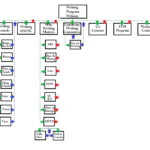At a time when anthropology didn’t exist making the modern History of anthropology not fully explained or understood as an applied science rather than pure. In which in return caused forensic to be avoided for decades making it’s finding admissible in courts. However, the 19th century murder of Dr George Parkman in whom was a Harvard Medical School Doctor created the field of forensic anthropology while also revolutionizing laws in the process. Parkman was born into a wealthy Boston family and entered Harvard at just the age of 15. George was well known for lending money from his fortune considered a loan shark in which he was also known for walking around collecting debts owed to him in town. (1)
John White Webster in whom was a chemistry as well as geology professor at Harvard was one of Parkman debtors. Webster ran into deeply bad financial problems requiring him to resign his family’s mansion. Borrowing money in the sum of 400 dollars was Webster from Parkman in 1842, however in today’s dollars equal to 10,000. Repayment is put off racking up principal and interest until 1849 summing to nearly 60,000 in today’s dollars. Parkman held collateral in which Webster used making them collateral to his debt, borrowing money from another to collect this in return made Webster very angry. (1)
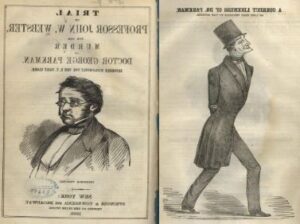
(Image on the Left Parkman, Right Webster)
On November 23 1849 seen entering Harvard Medical College was Parkman and Webster in which later there was no sign of either with doors locked and running water in which was reported by the janitor. On November 24th, Parkman’s family became worried after he had not returned home. On November 25th along with the police searched for Parkman. On November 26th posting notices concerning Parkman with assumptions of kidnapping and 3,000 cash reward if found alive. (2)
The police also searched the Charles River and Boston Harbor. Types of search methods included visual foot searching. With the janitor Ephraim Littlefield becoming suspicious of Webster behavior as the police were eying him for the murder as a suspect, he decided to do an investigation of his own. On November 29th 1849, After, following and spying on Webster in the lab started digging layers. On November 30th now considered a recover scene, consisting of recovery exposing as well as removing remains from surface, inside, the janitor findings after using tools as such as hatch, drill, and crow bar. (2)
On November 30th after continuous digging findings were terrifying and included a buried human pelvis, dismembered thigh and lower leg. Now developed as a search and recovery. Finding the remaining of the human remains were followed up by police and coroner an archaeological investigation in which a coroner jury would be created determining a judgement about disposition of case. Including a systemic search recovery, several men to retrieve remains, determining if it’s bone, documentation, interpretation, consisting of locating remains evidence. In which findings of the search lab recoveries in large chest consisted of a partially burned torso with a thigh stuck inside. Searches in which of that of subsequent turning up bloody clothing belonging to Webster. Stains from testing confirmed to be copper nitrate in which is a substance affective for moving blood. 2)
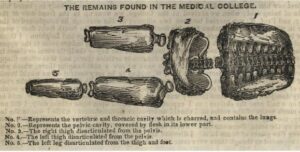
(Evidence of human remains found)
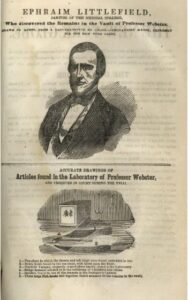
(Pictured Webster as well as evidence of evidence found in his lab)
Personal identification consisted of Mrs. Parkman being able to identify her husband body based off birthmarks and genitals. Along with estimations that of which were determined by the end of the day estimating that of male and height of 5’10 in which matched the identity features of George Parkman. Since at the time forensic anthropology hadn’t been discovered, although forensic anthropology helped this case by the year of 1850, March 19th, with important media coverage “The Parkman murder trial of Prof. John Webster for Murder of George Parkman, November, 23, 1849” printed by Daily Mail Office 1850 in which cases was one of the first to involve forensic anthropology. (1)
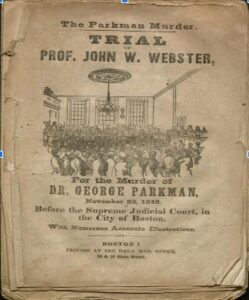
(“The Parkman murder: trial of Prof. John W. Webster for the murder of Dr. George Parkman, November 23, 1849 (Boston: Printed at the Daily mail Office, 1850)” (1)
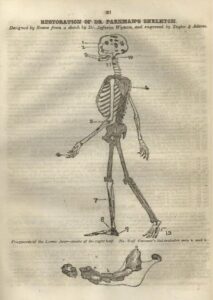
(Dr George Parkman Skeleton used as evidence)
Including forensic odontology, forensic document analyst, identity, manner and cause of death. The earliest example of modern anthropology work, consisting of testifying and discussing jaw found pertaining to dental evidence and forensic science. Experts in handwriting also analyzing notes Webster had written calming to have paid Parkman off. Explanations also included suspects deep knowledge of anatomy in which dismembered by suspect pertaining to the way decapitation of body. In my opinion, this case went cold for so long reasoning being in the 19th century murder cases had to be considered “absolute certain” of guilt in which prosecution would have to prove Webster killed Parkman purposely, as well as beyond a reasonable doubt. In which the term reasonable doubt wasn’t define by the U.S. Supreme Court until 1880. In which the case of the Murder of Parkman on March 30th a jury deliberated and April 1st a guilty verdict sentenced Webster to death by public hanging. (1)
Reference Page

